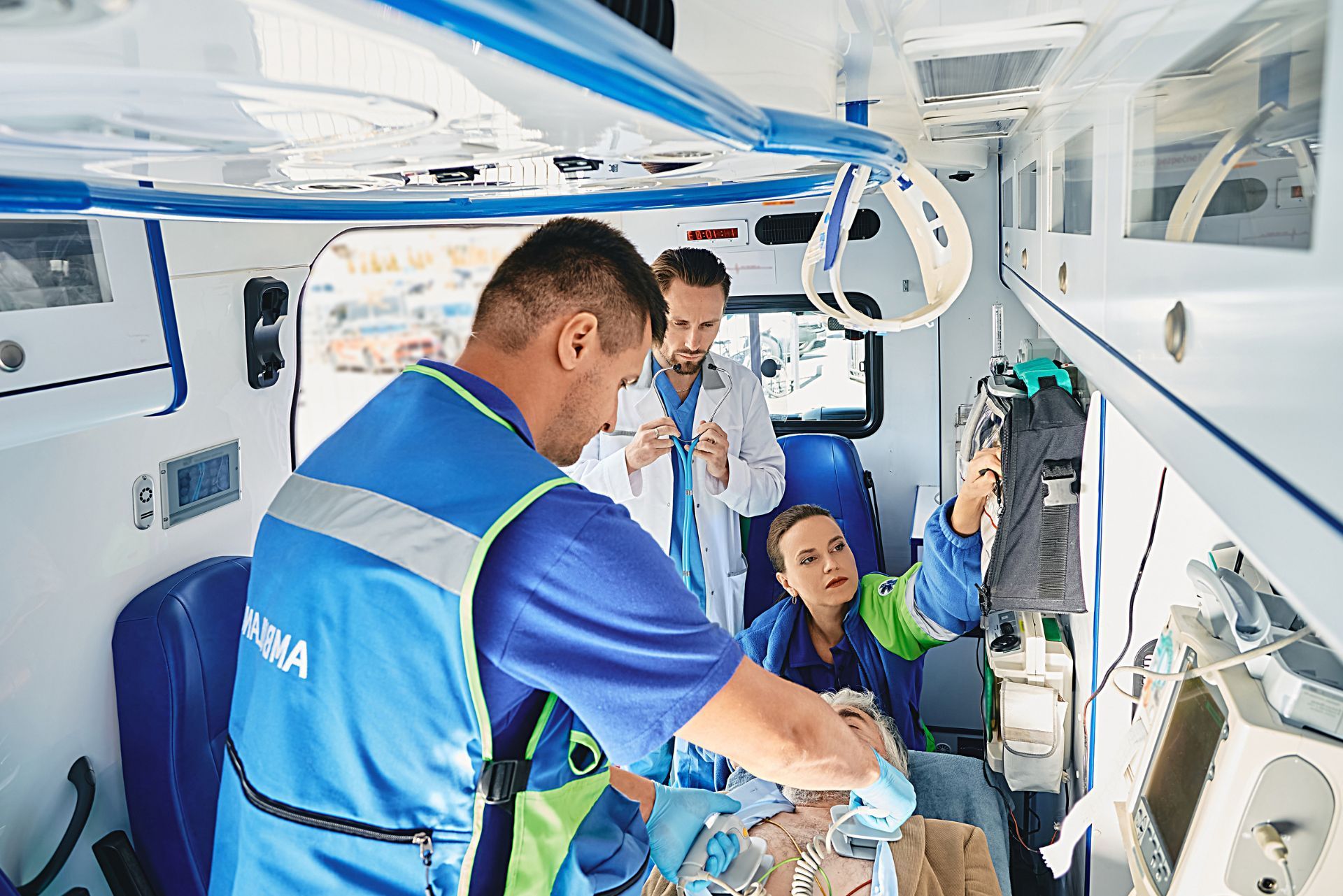Top 3 Recommended Policies

Medical transport services play a crucial role in ensuring patients receive timely and appropriate care. In Minnesota, the landscape of medical transport insurance is complex and multifaceted. Understanding the intricacies of this insurance is essential for both patients and providers. This article delves into the various aspects of medical transport insurance in Minnesota, including types of coverage, eligibility requirements, and the claims process.
Understanding Medical Transport Services
Medical transport services encompass a range of transportation options designed to move patients to and from healthcare facilities. These services can include ground ambulances, air ambulances, and non-emergency medical transportation (NEMT). Each type of service has its own unique characteristics and insurance implications, which can significantly impact patients' access to necessary medical care.
Types of Medical Transport
In Minnesota, medical transport services can be broadly categorized into three main types:
- Emergency Medical Services (EMS): These services are critical for transporting patients experiencing life-threatening conditions. EMS is typically covered by most health insurance plans, but coverage specifics can vary. The rapid response of EMS teams can be the difference between life and death, as they are trained to provide immediate medical assistance during transit.
- Air Ambulance Services: Used for rapid transport over long distances, air ambulances are equipped with advanced medical technology. Given their high costs, insurance coverage can be more complicated. Air ambulances are often deployed in rural areas where ground transport may take too long, ensuring that patients receive timely care, especially in critical situations.
- Non-Emergency Medical Transportation (NEMT): This service is designed for patients who need transportation for scheduled medical appointments but do not require urgent care. NEMT is often covered under Medicaid and some private insurance plans. This service is particularly important for individuals with mobility issues or those who lack access to reliable transportation, as it helps to reduce missed appointments and ensure continuity of care.
Importance of Medical Transport Insurance
Having appropriate medical transport insurance is vital for ensuring that patients do not face exorbitant out-of-pocket costs during emergencies. It provides peace of mind knowing that transportation to necessary medical care is covered. Furthermore, it can help healthcare providers ensure that patients receive the care they need without financial barriers. In addition to covering transport costs, insurance can also facilitate access to specialized services, such as neonatal transport for critically ill infants or inter-facility transfers for patients requiring specialized treatments that are not available at their local hospitals.
Moreover, understanding the nuances of medical transport insurance can empower patients to make informed decisions about their healthcare. Many insurance policies have specific networks of providers, and being aware of these can help patients avoid unexpected bills. Additionally, some states, including Minnesota, have programs designed to assist low-income individuals with transportation to medical appointments, further highlighting the importance of navigating the insurance landscape effectively. By being proactive about their medical transport options, patients can ensure that they receive timely and appropriate care while minimizing financial stress.

Types of Medical Transport Insurance Coverage
In Minnesota, there are several types of insurance coverage that may apply to medical transport services. Understanding these can help patients navigate their options effectively.
Health Insurance Plans
Most health insurance plans cover emergency medical transport services, but the extent of coverage can differ significantly. Some plans may require prior authorization, while others may have specific networks of providers. It is essential to review the details of a health insurance policy to understand what is covered. Additionally, patients should be aware that some plans may impose limits on the number of transport services covered per year or may only cover transport to certain facilities. Therefore, it is crucial for individuals to communicate with their insurance providers to clarify any ambiguities regarding their coverage.
Medicaid and Medicare
For eligible individuals, both Medicaid and Medicare offer coverage for medical transport services. Medicaid generally covers NEMT for beneficiaries who have no other means of transportation to medical appointments. Medicare, on the other hand, covers ambulance services when deemed medically necessary, but it does not cover NEMT. It is important to note that for both programs, the definition of "medically necessary" can vary, and patients may need to provide documentation or a doctor's note to justify the need for transport. Furthermore, the process for obtaining approval can sometimes be lengthy, so planning ahead is essential for those who anticipate needing transport for regular medical visits.
Supplemental Insurance
Many individuals opt for supplemental insurance to cover gaps in their primary health insurance. This type of insurance can provide
additional coverage for medical transport services, particularly for air ambulances, which can be quite costly. It is advisable to assess the benefits of supplemental insurance based on individual health needs. Moreover, some supplemental plans may offer added perks, such as coverage for non-emergency medical transport, which can be beneficial for patients who require regular visits to specialists or rehabilitation centers. As healthcare costs continue to rise, having a comprehensive understanding of all available insurance options can significantly alleviate the financial burden associated with medical transport services.
Eligibility for Medical Transport Insurance
Eligibility for medical transport insurance can vary based on the type of service and the insurance provider. Understanding these eligibility requirements is crucial for patients seeking coverage, as it can significantly impact their access to necessary medical care during critical times. Each insurance policy may have its own stipulations, so patients should take the time to review their specific plan details and consult with their insurance representatives for clarity.
Criteria for Emergency Transport
To qualify for emergency medical transport coverage, patients typically must meet specific criteria, including:
- The transport must be deemed medically necessary by a healthcare provider.
- The patient must be in a condition that requires immediate transport to a medical facility.
Documentation from the healthcare provider is often required to support the claim for coverage. This documentation may include detailed notes on the patient's condition, the urgency of the situation, and the recommended transport method, whether by ambulance, helicopter, or other means. In some cases, insurance companies may also require prior authorization before the transport occurs, which can add another layer of complexity to the process. Therefore, it is advisable for patients or their caregivers to communicate closely with healthcare providers to ensure all necessary paperwork is completed promptly.
Non-Emergency Transport Eligibility
For Non-Emergency Medical Transport (NEMT), eligibility criteria may include:
- Being a Medicaid recipient who requires transportation to covered medical services.
- Having no other means of transportation available.
Patients should contact their Medicaid provider to confirm eligibility and understand the process for arranging NEMT services. Additionally, it is important for patients to be aware that NEMT services can cover a variety of medical appointments, including routine check-ups, physical therapy sessions, and specialist consultations. Some states may also offer expanded services that include transportation for non-medical needs, such as grocery shopping or attending social services appointments, which can be especially beneficial for individuals with limited mobility or access to public transportation. Understanding the full scope of what NEMT can offer may help patients maximize their benefits and ensure they receive the care they need without unnecessary delays.
The Claims Process for Medical Transport Insurance
Filing a claim for medical transport services can be a daunting process. However, understanding the steps involved can simplify the experience and increase the likelihood of a successful claim.
Gathering Necessary Documentation
The first step in the claims process is to gather all necessary documentation. This includes:
- Medical records indicating the necessity of transport.
- Invoices or receipts from the transport service.
- Any pre-authorization documents if required by the insurance provider.
Having complete and accurate documentation is essential for expediting the claims process. In addition to the standard paperwork, it may also be beneficial to include a detailed letter from the attending physician explaining the medical necessity of the transport. This can provide further context and strengthen the case for coverage. Furthermore, keeping copies of all submitted documents is crucial, as it allows for easy reference in case of disputes or follow-up inquiries.
Submitting the Claim
Once the documentation is gathered, the next step is to submit the claim to the insurance provider. This can often be done online or via mail. It is important to follow the specific submission guidelines provided by the insurance company to avoid delays. Some providers may require claims to be submitted within a certain timeframe after the transport service was rendered, so being aware of these deadlines is essential. Additionally, utilizing a claims tracking system, if available, can help keep you informed about the status of your submission.
Follow-Up on Claims
After submitting the claim, it is advisable to follow up with the insurance provider to ensure it is being processed. If there are any issues or additional information required, addressing them promptly can help avoid unnecessary delays in receiving coverage. Regular follow-ups can also demonstrate your proactive approach and commitment to resolving the claim efficiently. If the claim is denied, understanding the reasons behind the denial is crucial. Requesting a detailed explanation can provide insights into what additional information may be needed for a successful appeal. In some cases, enlisting the help of a claims advocate or a healthcare professional familiar with the insurance process can be beneficial in navigating complex situations.

Common Challenges in Medical Transport Insurance
While medical transport insurance is designed to provide support, there are several common challenges that patients may encounter. Awareness of these challenges can help individuals navigate the system more effectively.
Denials of Coverage
One of the most significant challenges is the denial of coverage for medical transport services. This can occur for various reasons, including:
- Lack of medical necessity documentation.
- Transport not being pre-authorized when required.
- Services rendered by a non-network provider.
When a claim is denied, patients have the right to appeal the decision. Understanding the appeals process is crucial for those who believe their claim was unjustly denied. It is often beneficial to gather supporting documentation from healthcare providers that can substantiate the medical necessity of the transport. Additionally, patients should be aware of the timelines for filing appeals, as delays can further complicate the process and potentially result in additional costs.
High Out-of-Pocket Costs
Even with insurance, patients may still face high out-of-pocket costs, particularly for air ambulance services. It is essential to review the insurance policy to understand potential co-pays, deductibles, and limits on coverage. These costs can be exacerbated by the fact that air ambulance services are often billed at rates significantly higher than ground transport, leading to unexpected financial burdens. Patients should consider discussing payment plans or financial assistance options with their providers to alleviate some of these costs, especially in urgent situations where transport is necessary.
Complexity of Policies
The complexity of insurance policies can also pose a challenge. Patients may find it difficult to understand the specific terms and conditions of their coverage. Seeking assistance from a healthcare advocate or insurance specialist can help clarify any confusion. Furthermore, it is advisable for patients to proactively engage with their insurance company before a transport occurs, as this can provide clarity on what services are covered and any potential limitations. This preemptive approach can empower patients to make informed decisions about their care and avoid surprises when it comes time to settle bills.
Moreover, the landscape of medical transport insurance is continually evolving, with changes in regulations and coverage options. Staying informed about these changes can be crucial for patients and their families. Joining support groups or online forums where individuals share their experiences can provide valuable insights and tips on navigating the complexities of medical transport insurance. Such community resources can be instrumental in helping patients feel less isolated in their journey and more equipped to handle the challenges that arise.
Tips for Navigating Medical Transport Insurance
Successfully navigating medical transport insurance requires diligence and awareness. Here are some practical tips to help individuals manage their coverage effectively.
Review Insurance Policies Regularly
Regularly reviewing insurance policies is essential to stay informed about coverage changes. This includes understanding any modifications to terms, conditions, or benefits that may occur annually. Additionally, it is wise to compare your current policy with other options available in the market. This not only helps in identifying potential savings but also ensures that you have the best coverage tailored to your specific needs, especially if your health circumstances change over time.
Communicate with Healthcare Providers
Maintaining open communication with healthcare providers can help ensure that necessary documentation is provided for claims. Providers can assist in explaining the medical necessity of transport, which is crucial for successful claims. It’s also beneficial to keep a record of all communications with your healthcare team, including dates, names of individuals spoken to, and details discussed. This documentation can serve as a reference point in case of disputes or misunderstandings with your insurance company.
Utilize Resources and Support
Many organizations and resources are available to assist individuals in understanding their medical transport insurance options. Local health departments, advocacy groups, and insurance brokers can provide valuable information and support. Furthermore, online forums and community groups can offer insights from others who have navigated similar situations, sharing their experiences and tips. Engaging with these communities can provide not only practical advice but also emotional support during what can often be a stressful process.
Understand the Types of Medical Transport
It's important to understand the different types of medical transport covered by insurance, as this can greatly affect your coverage. Medical transport can range from ground ambulances to air ambulances, each with its own set of regulations and coverage requirements. Familiarizing yourself with these distinctions can help you advocate for the necessary transport services when needed. Additionally, some insurers may have preferred providers or networks, so knowing which services are in-network can prevent unexpected out-of-pocket expenses.
Document Everything
Keeping meticulous records of all medical transport services used, including dates, types of transport, and costs incurred, is vital. This documentation not only aids in filing claims but also serves as a safeguard against potential discrepancies with your insurance provider. In the event of a claim denial, having a comprehensive record can strengthen your case for an appeal. Moreover, tracking your medical transport usage can help you identify patterns in your healthcare needs, allowing you to make more informed decisions about your insurance options in the future.
Conclusion
Understanding Minnesota medical transport insurance is essential for patients and healthcare providers alike. By familiarizing themselves with the types of coverage available, eligibility criteria, and the claims process, individuals can better navigate the complexities of medical transport services. While challenges may arise, being proactive and informed can significantly enhance the experience and ensure that patients receive the care they need without undue financial burden.
Ultimately, the goal of medical transport insurance is to facilitate access to healthcare services, ensuring that individuals receive timely and appropriate care when they need it most. By staying informed and prepared, patients can make the most of their insurance coverage and advocate for their health effectively.
Contact Us

